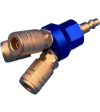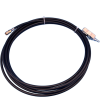
When it comes to maintaining a clean and healthy indoor environment, the importance of a well-functioning HVAC system cannot be overstated. The air you breathe indoors is often recirculated through an HVAC system, meaning that any dust, allergens, or contaminants in the ducts can end up in your lungs. This is why regular cleaning is crucial, and choosing the right vacuum for the job can make all the difference. In this blog post, we'll delve into the differences between HEPA vacuums and standard vacuums, specifically for HVAC cleaning.
Understanding the Basics
What is a HEPA Vacuum?
HEPA stands for High-Efficiency Particulate Air. A HEPA vacuum is designed to capture at least 99.97% of particles that are 0.3 microns in diameter. This is the size at which particles are most difficult to capture, making the HEPA filter highly effective for trapping dust mites, pollen, pet dander, and even tobacco smoke.
What is a Standard Vacuum?
Standard vacuums, on the other hand, generally do not come equipped with HEPA filters. While they can still pick up larger particles and debris, they are less effective at capturing the smaller particles that can pose health risks, especially to those with allergies or respiratory issues.
Historical Context
The concept of using vacuums for cleaning has been around since the early 1900s. However, it wasn't until the 1950s that HEPA filters were developed, initially for use in nuclear facilities to prevent the spread of radioactive particles. Over time, their application extended to various industries, including healthcare and, eventually, household and commercial cleaning.
Current Trends in HVAC Cleaning
With increasing awareness of indoor air quality and its impact on health, more homeowners and businesses are investing in regular HVAC cleaning. The trend leans towards using equipment that not only cleans but also improves air quality. This is where HEPA vacuums have gained popularity, particularly for those who suffer from allergies or asthma.
Comparing HEPA and Standard Vacuums
Efficiency in Particle Removal
- HEPA Vacuums: These are highly efficient in removing microscopic particles, ensuring that allergens and pollutants are captured and not recirculated back into the air.
- Standard Vacuums: While effective for larger debris, they often allow smaller particles to escape, which can defeat the purpose of cleaning ducts meant to improve air quality.
Health Implications
- HEPA Vacuums: Ideal for allergy sufferers and those with respiratory issues, as they significantly reduce the presence of allergens and irritants.
- Standard Vacuums: May not provide the same level of relief for sensitive individuals, given their limited capabilities in trapping small particles.
Real-World Scenario: The Allergy-Prone Family
Imagine a family with two young children, one of whom has severe dust allergies. The parents notice that despite regular cleaning, their child still experiences frequent allergic reactions. After switching from a standard vacuum to a HEPA vacuum for their HVAC cleaning, they notice a marked improvement in their child's condition. The HEPA vacuum effectively reduces the dust and allergens circulating in their home, leading to fewer allergy attacks.
Performance and Cost
Initial Investment
- HEPA Vacuums: Generally more expensive due to advanced filtration technology.
- Standard Vacuums: More budget-friendly upfront, but may incur additional costs if frequent filter replacements are required.
Long-Term Value
- HEPA Vacuums: Often justify their higher initial cost by providing better air quality and potentially reducing medical bills related to allergy treatments.
- Standard Vacuums: May save money initially but can fall short in delivering long-term health benefits.
Real-World Scenario: The Budget-Conscious Office
Consider a small office that prioritizes cost-effective solutions. Initially, they opt for a standard vacuum due to budget constraints. However, after noticing a rise in employees' sick days due to allergies, they reconsider and invest in a HEPA vacuum. Over time, the improved air quality translates to healthier employees and increased productivity, ultimately proving cost-effective in the long run.
Ease of Use and Maintenance
User Experience
- HEPA Vacuums: Often come with advanced features and settings designed to optimize cleaning efficiency.
- Standard Vacuums: Typically simpler to use but may lack the specialized settings of HEPA models.
Maintenance Requirements
- HEPA Vacuums: Require regular filter checks and replacements to maintain efficiency.
- Standard Vacuums: Easier to maintain but may require more frequent cleaning due to less effective filtration.
Environmental Considerations
Energy Consumption
- HEPA Vacuums: Some models are designed to be energy-efficient, although the technology can sometimes make them more power-intensive.
- Standard Vacuums: Generally consume less energy, but their inefficiency in cleaning might require more frequent use.
Sustainability
- HEPA Vacuums: Often part of eco-friendly cleaning practices due to their efficiency in improving indoor air quality.
- Standard Vacuums: May contribute more to environmental waste due to frequent disposal of less effective filters.
Potential Future Implications
As technology advances, we can expect improvements in vacuum design and efficiency, leading to even more effective cleaning solutions. The continued emphasis on indoor air quality could drive further innovation, making HEPA technology more accessible and affordable.
Emerging Technologies
- Smart HEPA Vacuums: Future models may include smart technology that monitors air quality and adjusts cleaning intensity accordingly.
- Eco-Friendly Materials: Development of biodegradable filters and components could reduce environmental impact.
Conclusion: Which is Right for You?
Choosing between a HEPA vacuum and a standard vacuum for HVAC cleaning ultimately depends on your specific needs and circumstances. If you or your family members suffer from allergies or asthma, investing in a HEPA vacuum could provide significant health benefits. For those with budget constraints, a standard vacuum might suffice, but consider the long-term implications on health and productivity.
In the ever-evolving landscape of cleaning technology, staying informed and making choices that align with your health and environmental values is key. Whether you prioritize cost, efficiency, or sustainability, understanding the differences between HEPA and standard vacuums will help you make an informed decision that promotes a healthier indoor environment.












Write a comment